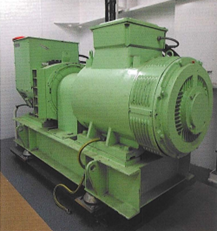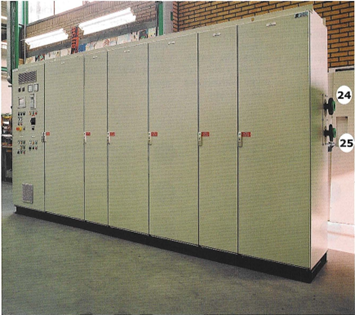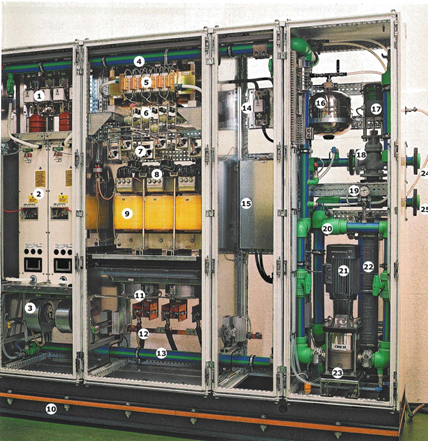Converters
Converters
07.09.2021
DC/AC converters
On small ships such as yachts, where the power supply is only obtained from batteries (a DC system), the choice of electrical equipment is restricted. It is difficult to find TV sets, audio equipment, microwaves, refrigerators, deepfreezes, fluorescent lighting, etc. suitable for a DC power supply. If available at all, they are expensive. For that reason DC/AC converters are used.
The most common converters are:
- Incoming supply: 12V, 24V and 48VDC
- Outgoing supply: 120V and 230V (50 and 60Hz)
- Capacity: up to 6 kW
DC/DC converters
DC/DC converters are used for the same reason DC/AC converters are used. For example, on small ships with 12V DC incoming and only 24V DC consumers available, a DC/DC converter can solve the problem.
Rotary converters
A rotary converter consists of an electric motor driven by the ship's power, mechanically connected to a generator. The generator is designed and constructed to produce the required voltage and frequency.
АС/AC converters


Air cooled AC/AC converter dosed, and with open doors:
1. Control panel
2. Main switches
3. Active front end inverters mak ing DC from AC and reverse and reverse
4. Inverters making AC out of DC.
The diagram below shows two double purpose converters. One converter produces the necessary current to the stern thruster supplied by the ship's switchboard when the ship is manoeuvring. The other converter supplies the bow thruster during manoeuvring. When the ship is moored, the same converter produces current to the ship's switchboard, fed by the shore supply. The arrows in the scheme show both purposes. The reason for this dual purpose function choice is the high cost of converters and the space required.

Of all converters the types that convert a primary AC input into a controlled AC output, the AC/AC converters, are the largest group. These converters are widely used as starting and control systems for AC motors. AC/AC converters control input currents from the net and can provide a controlled output of speed and torque to motors. They can also change the direction of rotation of an AC motor.
Using AC/AC converters can make an installation more cost effective as pumps or fans can be fine tuned to the process to which these are connected. For example the flow of a cooling water pump can be set to the actual temperature requirement of the system where such a pump would normally be running at full speed with a three-way valve controlling the cooling water temperature. In the same way the speed of ventilators or the motors of chiller units for an air-conditioning system can be controlled by an AC/AC converter.
The result will be that in the end less electrical energy will be consumed and that there will be less switching on and off of consumers. AC/AC converters are also used to control a wide range of large AC motor applications such as:
- propulsion motors
- thruster motors
- dredging pump motors - etc
AC/AC converters are available with voltage and current ratings to match the majority of 3-phase AC- motors. Low voltage AC/AC converters, up to 690V on ships, are available for motors rated 0.2 kW up to several megawatts (MW).
Medium voltage AC/AC converters are designed to operate at 3.3kV and up to 10 kV for use with motors rated 350kW and above. AC/AC converters with higher ratings should be considered to be one-of-a-kind designs.

Large water cooled AC/AC converter
AC/AC converters, in their simplest form, consist of the following main components:
- a supply transformer and rectifier converting AC into DC voltage
- a converter converting DC to AC with stepless controlled voltage and frequency.
A rectifier is not able to transfer reverse power to the power generation system. Thus when a motor is driven by the load, like can happen with for instance a winch or when lowering the load in a crane, the power generated cannot be dispersed. To overcome this braking resistors are added in the DC circuit which will convert the reverse power to heat.
When an AC/AC converter has controlled rectifiers it is called an Active Front End (AFE) drive. The advantage of an AFE drive is that the controlled rectifiers and filter inductors in the supply lines can make the AC current nearly sinusoidal, doing away with harmonic distortions.
An additional advantage of an AFE drive is the ability to feed back the energy from the DC side to the AC grid, doing away with the braking resistors mentioned earlier, should these be required. In order to obtain a wider input range, step-up transformers can be installed.
An example is the diagram on the previous page where step-up transformers are indicated. The step-up transformers transform the voltage from 320V (equal to 400V -20%) to 400V, creating an output of 400V-50Hz from an input range of 320 to 480V 50-60HZ.
AC/AC converters mostly consist of the following parts:
- Transformers to adapt input or output voltage
- Rectifiers to change AC to DC
- Inverters to correct fixed input voltage and frequency into desired voltage and frequency
- Active inverters the same as above but working in both directions as required
- Inverters to convert DC voltage into fixed AC voltage and frequency in both directions.
Large AC/AC converters are in general water cooled

The same converter as on the previous page but now without doors
1. Fast fuse
2. DC/AC converter
3. Ventilator
4. Cooling water outlet piping
5. Water cooled rectifier
6. Support isolators
7. Fuses
8. Connections to transformers
9. Transformers
10. Foundation
11. Outgoing connection
12. Outgoing phase cable
13. Cooling water pipe
14. Fuses
15. Braking chopper
16. Expansion vessel
17. Actuator
18. Cooling water regulating valve
19. Pressure indicator
20. Cooling water piping
21. Electric motor
22. Heat exchanger
23. Cdoling water pump
24. Cooling water inlet
25. Cooling water outlet
On small ships such as yachts, where the power supply is only obtained from batteries (a DC system), the choice of electrical equipment is restricted. It is difficult to find TV sets, audio equipment, microwaves, refrigerators, deepfreezes, fluorescent lighting, etc. suitable for a DC power supply. If available at all, they are expensive. For that reason DC/AC converters are used.
The most common converters are:
- Incoming supply: 12V, 24V and 48VDC
- Outgoing supply: 120V and 230V (50 and 60Hz)
- Capacity: up to 6 kW
DC/DC converters
DC/DC converters are used for the same reason DC/AC converters are used. For example, on small ships with 12V DC incoming and only 24V DC consumers available, a DC/DC converter can solve the problem.

Rotary converters
A rotary converter consists of an electric motor driven by the ship's power, mechanically connected to a generator. The generator is designed and constructed to produce the required voltage and frequency.
АС/AC converters


Air cooled AC/AC converter dosed, and with open doors:
1. Control panel
2. Main switches
3. Active front end inverters mak ing DC from AC and reverse and reverse
4. Inverters making AC out of DC.
The diagram below shows two double purpose converters. One converter produces the necessary current to the stern thruster supplied by the ship's switchboard when the ship is manoeuvring. The other converter supplies the bow thruster during manoeuvring. When the ship is moored, the same converter produces current to the ship's switchboard, fed by the shore supply. The arrows in the scheme show both purposes. The reason for this dual purpose function choice is the high cost of converters and the space required.

Of all converters the types that convert a primary AC input into a controlled AC output, the AC/AC converters, are the largest group. These converters are widely used as starting and control systems for AC motors. AC/AC converters control input currents from the net and can provide a controlled output of speed and torque to motors. They can also change the direction of rotation of an AC motor.
Using AC/AC converters can make an installation more cost effective as pumps or fans can be fine tuned to the process to which these are connected. For example the flow of a cooling water pump can be set to the actual temperature requirement of the system where such a pump would normally be running at full speed with a three-way valve controlling the cooling water temperature. In the same way the speed of ventilators or the motors of chiller units for an air-conditioning system can be controlled by an AC/AC converter.
The result will be that in the end less electrical energy will be consumed and that there will be less switching on and off of consumers. AC/AC converters are also used to control a wide range of large AC motor applications such as:
- propulsion motors
- thruster motors
- dredging pump motors - etc
AC/AC converters are available with voltage and current ratings to match the majority of 3-phase AC- motors. Low voltage AC/AC converters, up to 690V on ships, are available for motors rated 0.2 kW up to several megawatts (MW).
Medium voltage AC/AC converters are designed to operate at 3.3kV and up to 10 kV for use with motors rated 350kW and above. AC/AC converters with higher ratings should be considered to be one-of-a-kind designs.

Large water cooled AC/AC converter
AC/AC converters, in their simplest form, consist of the following main components:
- a supply transformer and rectifier converting AC into DC voltage
- a converter converting DC to AC with stepless controlled voltage and frequency.
A rectifier is not able to transfer reverse power to the power generation system. Thus when a motor is driven by the load, like can happen with for instance a winch or when lowering the load in a crane, the power generated cannot be dispersed. To overcome this braking resistors are added in the DC circuit which will convert the reverse power to heat.
When an AC/AC converter has controlled rectifiers it is called an Active Front End (AFE) drive. The advantage of an AFE drive is that the controlled rectifiers and filter inductors in the supply lines can make the AC current nearly sinusoidal, doing away with harmonic distortions.
An additional advantage of an AFE drive is the ability to feed back the energy from the DC side to the AC grid, doing away with the braking resistors mentioned earlier, should these be required. In order to obtain a wider input range, step-up transformers can be installed.
An example is the diagram on the previous page where step-up transformers are indicated. The step-up transformers transform the voltage from 320V (equal to 400V -20%) to 400V, creating an output of 400V-50Hz from an input range of 320 to 480V 50-60HZ.
AC/AC converters mostly consist of the following parts:
- Transformers to adapt input or output voltage
- Rectifiers to change AC to DC
- Inverters to correct fixed input voltage and frequency into desired voltage and frequency
- Active inverters the same as above but working in both directions as required
- Inverters to convert DC voltage into fixed AC voltage and frequency in both directions.
Large AC/AC converters are in general water cooled

The same converter as on the previous page but now without doors
1. Fast fuse
2. DC/AC converter
3. Ventilator
4. Cooling water outlet piping
5. Water cooled rectifier
6. Support isolators
7. Fuses
8. Connections to transformers
9. Transformers
10. Foundation
11. Outgoing connection
12. Outgoing phase cable
13. Cooling water pipe
14. Fuses
15. Braking chopper
16. Expansion vessel
17. Actuator
18. Cooling water regulating valve
19. Pressure indicator
20. Cooling water piping
21. Electric motor
22. Heat exchanger
23. Cdoling water pump
24. Cooling water inlet
25. Cooling water outlet
 +7 (812) 4-673-673
+7 (812) 4-673-673